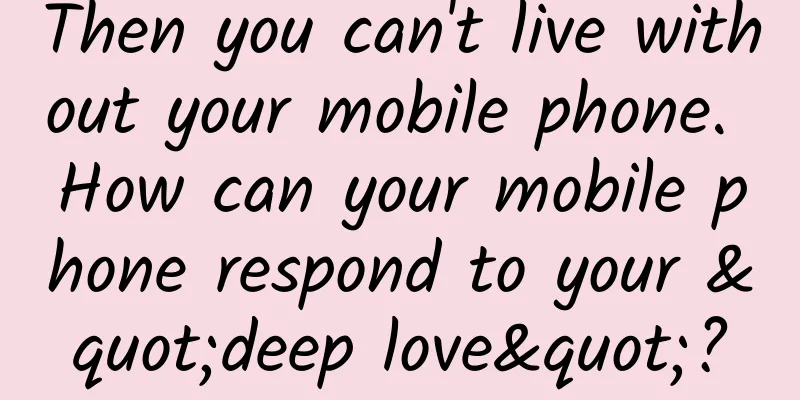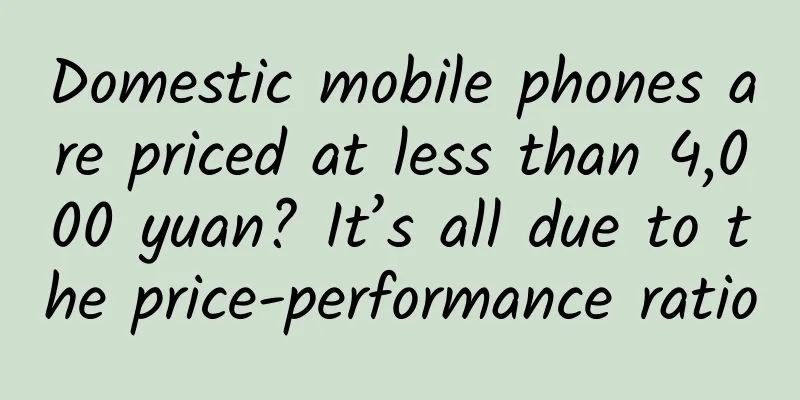Then you can't live without your mobile phone. How can your mobile phone respond to your "deep love"?

|
Author: Cui Yihui, registered dietitian Reviewer: Wang Junbo, Associate Professor and Doctoral Supervisor, Peking University Health Science Center When I was looking up information, I found a new term, "transient smartphone blindness". This new term originally originated from two cases in the New England Journal of Medicine in 2016. The common feature of these two cases is that the patients' monocular vision decreased, and both occurred within a few minutes of looking at the phone in a dark environment, one before going to bed, and the other after waking up. In 2017, another such case was reported. Fortunately, these three patients with transient smartphone blindness all had physiological monocular vision loss, and the blindness symptoms were short-lived and recoverable. But I believe they must have been scared out of their wits. Nowadays, people don’t feel anxious when they go out without their wallets, watches, or even keys, but they will feel anxious when they leave their phones. How many people have seriously thought about how much “unbearable weight in life” our eyes are bearing? The culprit is the short-wave blue light emitted by the mobile phone screen. We all learned in middle school physics class that natural light is composed of various color spectra. Light of different wavelengths presents different colors visually. For example, light with a wavelength of 605-700 nm is red light; light with a wavelength of 580-595 nm is yellow light; and light with a wavelength of 450-80 nm is ordinary blue light. The wavelength range of 400-440 nm is short-wave blue light. The shorter the wavelength, the higher the energy of the light and the stronger the penetration. With the rapid development of electronic technology, more and more electronic products have entered the daily life of ordinary people, so the human eye has more and more opportunities to "closely contact" with blue light. The peak spectrum of the light source of light-emitting diode (abbreviated as "LED") light source and various electronic products such as computers, mobile phones, and TV screens that use LED as the light source are all short-wave blue light. Modern life is inseparable from these electronic products, but they can cause various damages to the eyes. Figure 1 Copyright image, no permission to reprint 1. What damage can short-wave blue light cause to our eyes? 1. Affecting the physiological development of the eyes The degree of harm caused by blue light to the eyes varies with age. The younger the age, the greater the harm. Children are more sensitive to blue light and are more likely to suffer from sensory cell damage, vision loss and other eye diseases after exposure to blue light. 2. More prone to visual fatigue and blurred vision. The Visual Health Laboratory of the China National Institute of Standardization has conducted a study on the impact of LED blue light on visual fatigue of the human eye. The results show that high-frequency blue light makes the subjects more prone to visual fatigue. 3. Causes macular degeneration in the human eye. Damage to the macula can cause visual distortion, leading to a significant decrease in vision (especially central vision), affecting the quality of life, and even causing blindness. 4. Cataracts are induced at an earlier age. The main cause of cataracts is related to the high-frequency blue light in sunlight. In the past, cataracts were mostly seen in the elderly, but now the age of cataracts is trending towards younger people. Staring at the phone for several hours every day, the blue light radiation to the eyes is concentrated for several years. Whose eyes can bear such an overdraft? 5. Affects sleep quality : Studies have shown that blue light inhibits the secretion of melatonin (a key hormone for high-quality deep sleep). Nowadays, many people say that they have poor sleep at a young age, are always listless during the day, and have low work efficiency. However, when it comes to bedtime at night, they habitually take their mobile phones or tablets to bed, chat, watch TV series, and browse Moments in the dark. Over time, sleep quality declines and insomnia becomes the norm. 2. How to avoid blue light radiation damage to the eyes From 2006 to 2013, an average of more than 60,000 people worldwide were blinded by blue light radiation each year. The World Health Organization (WHO) Eye Care Association has issued an orange alert on the potential threat of blue light radiation to humans worldwide. Some experts even said that if we don't pay attention to the damage of blue light to the eyes, more "eye problems" will appear in a few years, and their destructiveness is no less than chronic diseases such as cancer, diabetes and hypertension. Figure 2 Copyright image, no permission to reprint 3. What should we do to protect our eyes? 1. Avoid looking at your phone for long periods of time . Don’t look down at your phone all the time. Look at it while working, eating, walking, going to the toilet, before going to bed, when you wake up, during the day, at night... Don’t let your entire life be kidnapped by your phone. 2. Wear professional glasses When you have to look at the mobile phone screen for a long time, you can wear glasses that can block blue light, or put "glasses" on the electronic screen - a film to block the release of blue light. But it must be emphasized that blue light will not be completely blocked by these products, so you should not indulge yourself and always remember the first suggestion. 3. Lower the brightness of your phone . It is well known that Asians prefer a "cool screen". However, the cooler the color, the higher the blue content in the pigment, which is more likely to cause damage to the eyes. Therefore, we can lower the color temperature of the phone to protect our fragile retina. Of course, the screen brightness should not be adjusted too low, otherwise it will also hurt the eyes. It is best to choose "Automatically adjust the brightness of the phone". 4. Don’t look at your phone in the dark . Don’t look at your phone in the dark! Don’t look at your phone in the dark! (Important things to say three times) 5. Learn to provide nutritional protection for the eyes and improve their own repair ability (1) Purple fruits and vegetables containing anthocyanins: Anthocyanins are powerful antioxidants that can remove free radicals that damage blood vessels in the eyes, maintain normal cell connections, improve eye microcirculation, and maintain sharp vision. (2) Yellow, orange, and red fruits and vegetables containing lutein, zeaxanthin, and beta-carotene. Lutein and zeaxanthin are the main pigments that make up the macula of the retina. They can prevent and improve vision loss caused by macular degeneration of the retina, block damage to the eyes caused by ultraviolet rays and short-wave blue light, such as visual fatigue, blurred vision, cataracts, macular degeneration, etc., and promote the regeneration of rhodopsin in retinal cells. Beta-carotene can be converted into vitamin A in the human body and is the main component of retinal rhodopsin. If the body lacks vitamin A, the retina will become insensitive to light and even night blindness will occur. (3) Supplement DHA: DHA is the main raw material for building the optic nerve. Supplementing DHA is very beneficial for maintaining good vision. Figure 3 Copyright image, no permission to reprint |
<<: How can we prevent cancer before it happens?
>>: Is it really necessary to clean barnacles from whales and turtles?
Recommend
24 sets of money-making business tips, you can use them right away, and you can earn over 10,000 yuan a month at home
24 sets of money-making business tips, you can us...
The 499-yuan Douyin reposting course: how to make the Douyin reposted video original
The 499-yuan Douyin reposting course: how to make...
Former Faraday executive reveals: Jia Yueting won’t be able to pay salaries next year
While many people are waiting for their company&#...
The dilemma Chinese Internet companies leave for Apple
[[124156]] On November 16, Sogou Number Lite iOS ...
Will you get more wet walking in the rain or running in the rain?
If it rains one day and you don’t have an umbrell...
WM Motor brought the world's most powerful 1.8-second "WM Champion" and the new WM W6 520km ACE Extreme Edition equipped with OTA2.0 version to the Chengdu Auto Show!
On August 29, WM Motor, the "number one smar...
Analysis of Tik Tok media advertising in Q1 2020!
Douyin’s DAU has exceeded 400 million, a 60% incr...
Complete a landing page design in 7 steps!
User decision-making is an uphill process. The va...
Selection of App diversion solutions under H5 mainstream browsers
Recently, several business product lines have bee...
How can Douyin individual business owners authenticate the corporate Blue V? How to enter Douyin as a self-employed person!
Today, the hot trend of Douyin has continued. Reg...
China CDC latest release! The new coronavirus seems to be unable to spread! Latest judgment →
On January 28, the Chinese Center for Disease Con...
7 key points to explain the strategy of recalling lost users
This article introduces the value of recalling lo...
Community Operation Guide: How to double the activity?
Community is as important as socializing . People...
What "magic weapon" do embryologists have to help the birth of test-tube babies? ——Written on "Embryologists' Day"
Author: Fu Jing, Chief Physician, Shanghai Ji'...
Is calcium carbonate toothpaste harmful to teeth?
As an oral care product, the safety of toothpaste...









